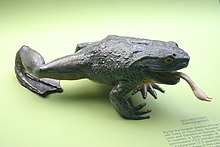Goliath frog
| Goliath frog | |
|---|---|

| |
| Scientific classification | |
| Domain: | Eukaryota |
| Kingdom: | Animalia |
| Phylum: | Chordata |
| Class: | Amphibia |
| Order: | Anura |
| Family: | Conrauidae |
| Genus: | Conraua |
| Species: | C. goliath
|
| Binomial name | |
| Conraua goliath | |

| |
The goliath frog or giant slippery frog (Conraua goliath) is the biggest type of frog on Earth. It can grow to 32 centimetres (12.6 inches) long and weigh up to 3.25 kilograms (7.17 pounds). Its natural habitat is western Africa.
In 2019, scientists learned that the frog does something unusual: It digs pools to lay eggs in. The scientists think it is the male frog who digs the pool. Because not all the tadpoles in each pool were the same size, the scientists came to think that frogs lay eggs in the same pool more than once. The frogs move sand, pieces of plants, and stones almost as big as they are. They use the stones and plants to build higher walls for the pool. Scientists saw adult frogs staying near the pools at night to scare away bigger animals that wanted to eat the tadpoles. Scientists think this might be why the goliath frog is so big: Bigger frogs can move bigger rocks, build bigger pools and scare away bigger predators.[2]
References[change | change source]
- ↑ "Conraua goliath". IUCN Red List of Threatened Species. Version 2014.3. International Union for Conservation of Nature. 2004. Retrieved 2015-05-08.
- ↑ Elizabeth Pennisi (August 8, 2019). "The world's biggest frogs build their own ponds". Science Magazine. Retrieved September 25, 2020.

